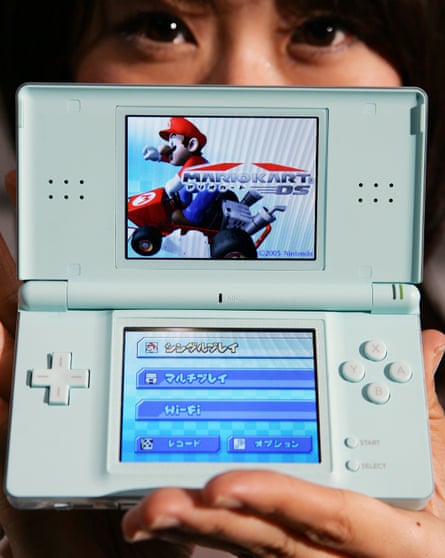As a result of a house move that grew more complicated with every passing day, I have spent another couple of weeks in the barbaric situation of not having a gigantic TV to play games on. So I have continued to seek solace in storage boxes containing handheld consoles of the past – specifically, this time, an old Nintendo DSi and assorted cartridges.
This machine was mainly used by my kids more than a decade ago, when they were aged between six and 11, so the bag is full of loose games such as Nintendogs, Eco Creatures: Save the Forest, Tamagotchi Connection: Corner Shop and Catz – games that hold no interest for a man in his 50s, and whose spelling offends me.
I excitedly reach for Guitar Hero: On Tour, but then the game informs me that “you cannot rock without a Guitar Hero Guitar Grip (TM)”, and I have no idea where that has gone. History has swallowed it and its trademark up, somewhere. No rocking for me. That’s a shame, because I remember it as a pretty cool peripheral, or at least as cool as it’s possible to be while wrapping your fist around a Nintendo DS and pretending that you are Eddie van Halen.

Then I spy gold: the R4 Revolution and Acekard 2! These were special cartridges, bought from mythical, far off lands, that could play illegally downloaded copies of DS games. You could fit 50 of them on a tiny micro-SD chip. I have no idea how they got in there because obviously I, Dominik Diamond, would never have anything to do with video game piracy. Luckily, they don’t work, so the financial wellbeing of the video games industry remains intact, along with my legacy.
I try Rainbow Islands Revolution instead. Classic platform action; just what I need. Except it’s not one of those good revolutions I enjoyed hearing about at school, which gave the world agricultural independence or trains. This one just gives me a headache. Simple rainbow platform fun has given way to some horribly frustrating pseudo-platformer where you drag your guy around the screen using the stylus. Stylus control is just weird in a platformer; you can move too freely, compared to D-pad and buttons. It’s like using a Ferrari to mow your lawn. And my hands feel twice as clumsy as they did back then. They are middle-aged sledgehammers trying to crack the tiniest walnuts.
Maybe there’s more to it, but I’ll never know, because there are no in-game instructions. We complain about how slow tutorial levels can be, but now I realise how crucial they are ever since the world cast aside boxes and instruction manuals. My old DS games do not have tutorial levels and they aren’t in their original boxes – so there are no manuals. This means that when I play Puzzle de Harvest Moon, it is like being thrown into Squid Game. I am in the middle of a game I have no rules for, and it’s giving me a panic attack.
Luckily, Penguins of Madagascar does have tutorial levels. And it is a delightful little game to play: Lemmings in 3D, without the time limit. I remember taking my kids to the movie, which was probably why I bought them the game. Cooking Mama is also great to play, not just because using a stylus for cooking actions makes perfect sense, but also because it came out at a time when my own kids were first going to sushi places, so this was one of our favourites. I feel warm and yummy playing it even when I totally fail to boil an egg.

This is the Nintendo DS for me. It’s the machine I shared with my kids. It’s not just about the nostalgic glow of games that have stood the test of time (Elite Beat Agents is still the funniest, most insane, most beautifully crafted stylus game ever). There is also a bonus level that no game could ever give me: the photographs saved on the console’s camera.
Each time I switch it on, I get a different photo of my son with superimposed Mario moustaches, crowns and yellow cartoon tears. He is the eight-year-old cutie of yesteryear, in contrast to the big, smelly 18-year-old who no longer listens to what I say or wants to play any games or watch any movies with me. This 18-year-old is also on the other side of the world from me just now, and this machine lets me see his beautiful little face. It’s a reminder of Nintendo’s most important legacy. Even though Sega had the jump on Nintendo in the 1990s, with more powerful hardware and more games and cooler advertising, Nintendo became part of family life. I don’t have a Game Gear with photos of my son from a decade ago, making me well up in tears.
Nintendo consoles are part of my family history, etched into our hearts. That’s more than just a game.
